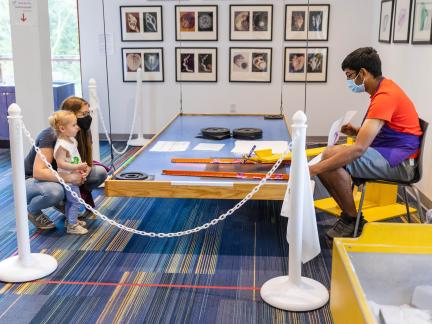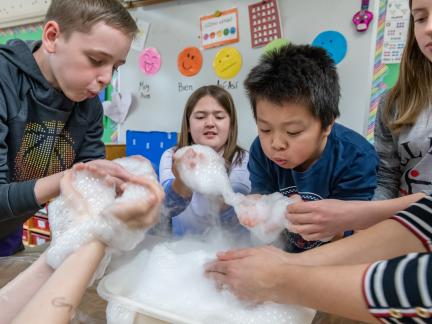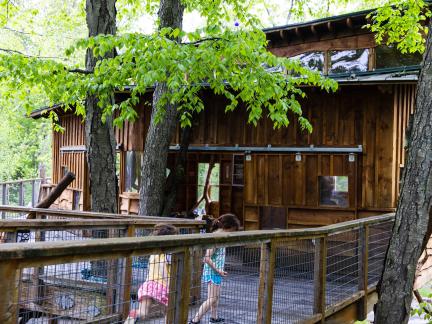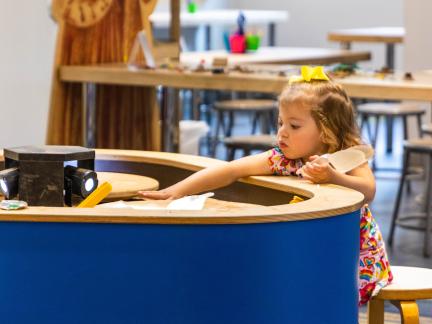Student Activity Supplements
This content series, created specifically for teachers and their students, provides learning experiences that use simple, everyday materials so you and your students can create and explore STEM concepts either at home or in the classroom. Every activity includes a suggestion that students share their discoveries with us using a special email address—we would love to hear from them! These resources are free, but if you find them useful to your students we would love to hear about it!
These explorations can provide terrific complementary learning to an in-class or virtual Traveling Science Workshop or a class Field Trip to the Museum.
Questions, comments, feedback? Please connect with us by emailing jfoster [at] discoveryacton.org (Jill Foster), Director of School & Group Programs, or call her at 978-264-4200 ext. 118.
Make Your Own Exhibits
From the AirPlay Gallery: Bernoulli Blower
Students engage with force and motion principles as they explore the properties of moving air. Using simple materials found around the house, students experiment with air pressure as a force and see how it can be used to move and lift lightweight materials such as ping-pong balls, pom-poms, or even a piece of paper.
Related Discovery Museum Gallery: AirPlay
Grades: PreK-8
Activity length: 10-20 minutes
Curriculum: Force & Motion
Supports MA STE Standards for PreK-4: PreK-PS2-1(MA); K-PS2-1; 1.K-2-ETS1-1; 1.K-2-ETS1-2; 2.K-2-ETS1-3; 3-PS2-1; 3.3-5-ETS1-1; 4.3-5-ETS1-3; 4.3-5-ETS1-5(MA)
Make Your Own Exhibit: Bernoulli Blower
From the Sound Gallery: Bucket Radio
Using everyday materials and their senses, students explore sound vibration and amplification. These Bucket Radio activities make invisible sound energy visible!
Related Discovery Museum Gallery: Sound
Grades: K-5
Activity length: 10 to 30 minutes
Curriculum: Sound and Sound Waves
Supports MA STE Standards: 1-PS4-1; 4-PS4-1
Make Your Own Exhibit: Bucket Radio
From the Simple Machines Gallery: Linkages
Students investigate how to create and control motion using linkages constructed from everyday materials such as cardboard and tape. In the process, students apply critical engineering design practices, learning about the strength and weaknesses of different designs as well as limitations and advantages of different materials.
Related Discovery Museum Gallery: Simple Machines
Grades: 2-8
Activity length: 20-40 minutes
Curriculum: Force and Motion, Engineering Design
Supports MA STE Standards: 3.3-5-ETS1-1; 3.3-5-ETS1-4 (MA); 4PS#-1;4.3-5-ETS1-3;6.MS-ETS1-6(MA);6.MS-ETS2-2 (MA); 7.MS-ETS1-4
Make Your Own Exhibit: Linkages
From the Light & Color Gallery: Rays!
Students become light scientists as they explore light energy using a variety of materials gathered from around the house that either block, redirect, or let light pass through.
Related Discovery Museum Gallery: Light & Color
Grades: 1-8
Activity length: 30-50 minutes
Curriculum: Light Energy
Supports MA STE Standards: 1-PS4-3, 4-PS3-2, 4-PS4-2, 6-MS-PS4-2
From the Yes, It’s Math! Gallery: Sisyphus
The study of magnetism and mathematical pattern creation blend beautifully in this fun, hands-on activity that blurs the lines between science, math, and art. At the Museum, students are mesmerized by our Sisyphus exhibit which uses the invisible force of a magnet to attract a ferrous ball and carve amazing patterns and designs in sand. By constructing their own Sisyphus exhibit, students investigate and apply new knowledge about the properties of magnets and ferrous materials and develop an appreciation for pattern making and design.
Related Discovery Museum Gallery: Yes, It's Math!
Grades: K – 4
Activity length: 20 to 40 minutes
Curriculum: Magnetism and Geometry
Supports MA STE Standards: K.G.B6, 1.G.A2, 3-PS2-3
Make Your Own Exhibit: Sisyphus
From the Water Gallery: Build-a-Channel
Students come to appreciate the power of flowing water in this fun, interactive replication of our Build-a-Channel exhibit. By creating a constructed channel and allowing water to flow through it, students learn to control moving water by manipulating water volume and flow rate, the path the water takes, and its final destination. Applying this knowledge to a more naturalistic landform made with sand, soil, or other sediment, students directly observe the effects of erosion and how moving water shapes the earth. Through all of these experiences, students consider the impact natural or manmade structures have on land and water and by extension, the communities who live on and around them.
Related Discovery Museum Gallery: Water Gallery
Grades: PreK-5
Activity length: 20-40 minutes
Curriculum: Earth Science
Supports MA STE Standards: PreK-ESS3-1(MA), PreK-ESS3-2(MA), 2-ESS2-1, 2-ESS2-4(MA), 3-ESS3-1, 4-ESS1-1, 4-ESS2-1, 4-ESS3-2
Make Your Own Exhibit: Build-a-Channel
From the Sound Gallery: Pipes of Pan
Students will love listening to their world with this fun, easy-to-make exhibit. Pipes of Pan takes what can only be described as loud noise energy from the world and focuses the frequency of the vibrations to create recognizable notes. While experimenting with cardboard or paper tubes, students will begin to appreciate that sound is vibration that travels through air, solid, and liquids in waves at varying frequencies. Using different lengths of tubes, students discover that length of tube is directly related to the pitch of the note created.
Related Discovery Museum Gallery: Sound Gallery
Grades: PreK-5
Activity length: 15-25 minutes
Curriculum: Sound and Sound Waves
Supports MA STE Standards: PreK-PS4-1(MA), 1-PS4-1, 4-PS3-2, 4-PS4-1, 6.MS-PS4-1, 6.MS-PS4-2
Make Your Own Exhibit: Pipes of Pan
From the Water Gallery: Pour & Explore
Students will exercise their understanding of size and space as they use both liquids and solids to fill and empty containers of different sizes and shapes. Using water and their own small toys and other objects from around the home, students will pour their way through fractions and the concepts of capacity and volume. Rich in opportunities for hypothesizing, observation, and analysis, this exhibit allows students to compare properties of solids and liquids and how an object’s shape and volume affects its relationship to the space around it.
Related Discovery Museum Gallery: Water Gallery
Grades: PreK-8
Activity length: 25-40 minutes
Curriculum: Measurement & Data (Volume), Number and Operations (Fractions), Physical Science (Matter)
Supports MA STE Standards: PK.MD.A2, PreK-PS1-1(MA), PreK-PS1-2(MA), K.MD.A2, 2-PS1-2, 3.NF.A1, 5.MD.C4, 6.MS-PS1-7(MA)
Make Your Own Exhibit: Pour & Explore
Traveling Science Workshops (TSW) at Home
From the Liquids & Solids TSW: Ice Cube Adventure Game
Students engage in a fun chilly exploration, make observations and ask questions as they investigate what makes a solid turn into a liquid.
Related Traveling Science Workshop: Liquids & Solids
Grades: PreK-5
Activity Length: 15 to 30 minutes
Curriculum: Physical Changes
Supports MA STE Standards for PreK-4: PreK-LS1-3(MA), PreK-PS1-1(MA), PreK-PS1-4(MA), K-PS1-1(MA), K-PS3-1
Liquids & Solids: Ice Cube Adventure Game
From the Force & Motion TSW: Transfer of Energy
Students play with different types of balls and explore what makes something move, how to control the movement, how different forces effect the movement, and what happens when objects collide. Students can apply their new knowledge as they design and build their own balls and ramps contraption from everyday materials.
Related Traveling Science Workshop: Force & Motion
Grades: PreK-5
Curriculum: Force & Motion
Activity Length: 15 to 60 minutes
Supports MA STE Standards for PreK-4: PreK-PS2-1(MA); K-PS2-1; 3-PS2-1; 4-PS3-1; 4-PS3-3
Force & Motion: Transfer of Energy
From the Weather & Climate TSW: Observing, Predicting, and Responding to Weather
Students explore the difference between weather and climate and consider how both impact the way we live, work, and play. With heightened awareness, students also practice their skills of engineering as they design and build a structure in response to a climate-related need.
Related Traveling Science Workshops: Weather and Climate, Weather
Grades: PreK-5
Curriculum: Weather and Climate
Supports MA STE Standards for PreK to Grade 3: PreK-ESS2-4(MA); PreK-ESS2-5(MA); PreK-ESS2-6(MA); K-ESS2-1; K-ESS3-2; K-PS3-1; 3-ESS2-1; 3-ESS3-1; 3-5-ETS1-1, 3-5-ETS1-2
Weather & Climate: Observing, Predicting, and Responding to Weather
From the Simple Machines TSW: The Lever
Through a series of challenges, children learn about the lever, what it is and how it is used, all while developing an appreciation for and understanding of mechanical advantage. These introductory experiences can lay the groundwork for further study of all simple machines.
Related Traveling Science Workshop: Simple Machines Techology, Force & Motion
Grades: K-8
Activity Length: 20 to 60 minutes
Curriculum: Force and Motion, Engineering Design
Supports MA STE Standards for Grades 3-7: 3.3-5-ETS1-1; 3.3-5-ETS1-4 (MA);4.3-5-ETS1-3;6.MS-ETS1-6(MA);6.MS-ETS2-2 (MA); 7.MS-ETS1-4
From the Sound TSW: Exploring Sound as Vibration
Students are introduced to the concept of sound as vibration traveling through a medium such as a solid, liquid or gas and encouraged to apply their knowledge to create cool sound effects using everyday materials. Students will enjoy this blend of playful science and creative storytelling.
Related Traveling Science Workshop: Sound
Grades: K-6
Activity Length: 40 to 60 minutes
Curriculum: Sound
Supports MA STE Standards for PreK to Grade 4: PreK-PS2-1(MA), PreK-PS4-1(MA)1-PS4-1, 1-PS4-4, 1.K-2-ETS1-1, 4-PS4-1, 4-PS4-1, 4-PS4-3
Sound: Exploring Sound as Vibration
From the Chemistry Lab TSW: Chemical Reactions
Determining and describing the properties of a substance through observation is a scientific skill particularly relevant to chemistry. In this Traveling Science At Home, students will have an opportunity to explore chemical reactions through experiments that use every day ingredients they can find in the kitchen. Experiments include testing for acids and bases, removing tarnish from a penny, and investigating two different ways to reveal a secret message using their chemistry knowledge!
Related Traveling Science Workshop: Chemistry Lab
Grades: PreK-6
Activity Length: 40 to 60 minutes
Curriculum: Chemistry
Supports MA STE Standards for PreK to Grade 5: PreK-PS1-3, PreK-PS1-4, 2-PS1-1, 5-PS1-3, 5-PS1-4
Thank you to MathWorks, lead sponsor of Traveling Science Workshops, whose longstanding support has made possible our work to bring these supplemental resources to you.




